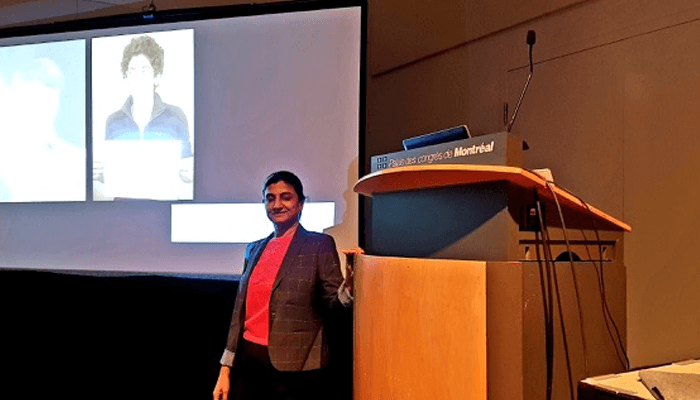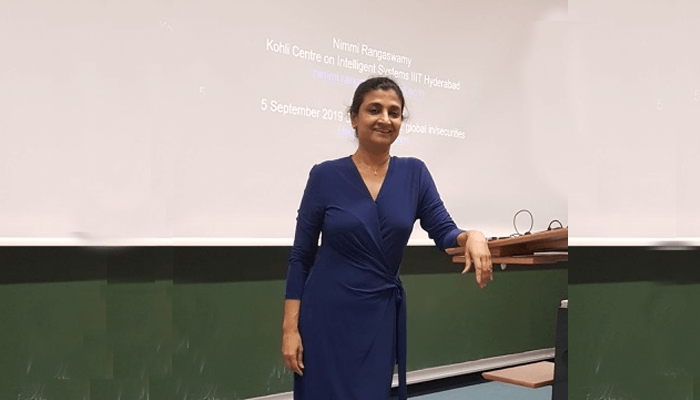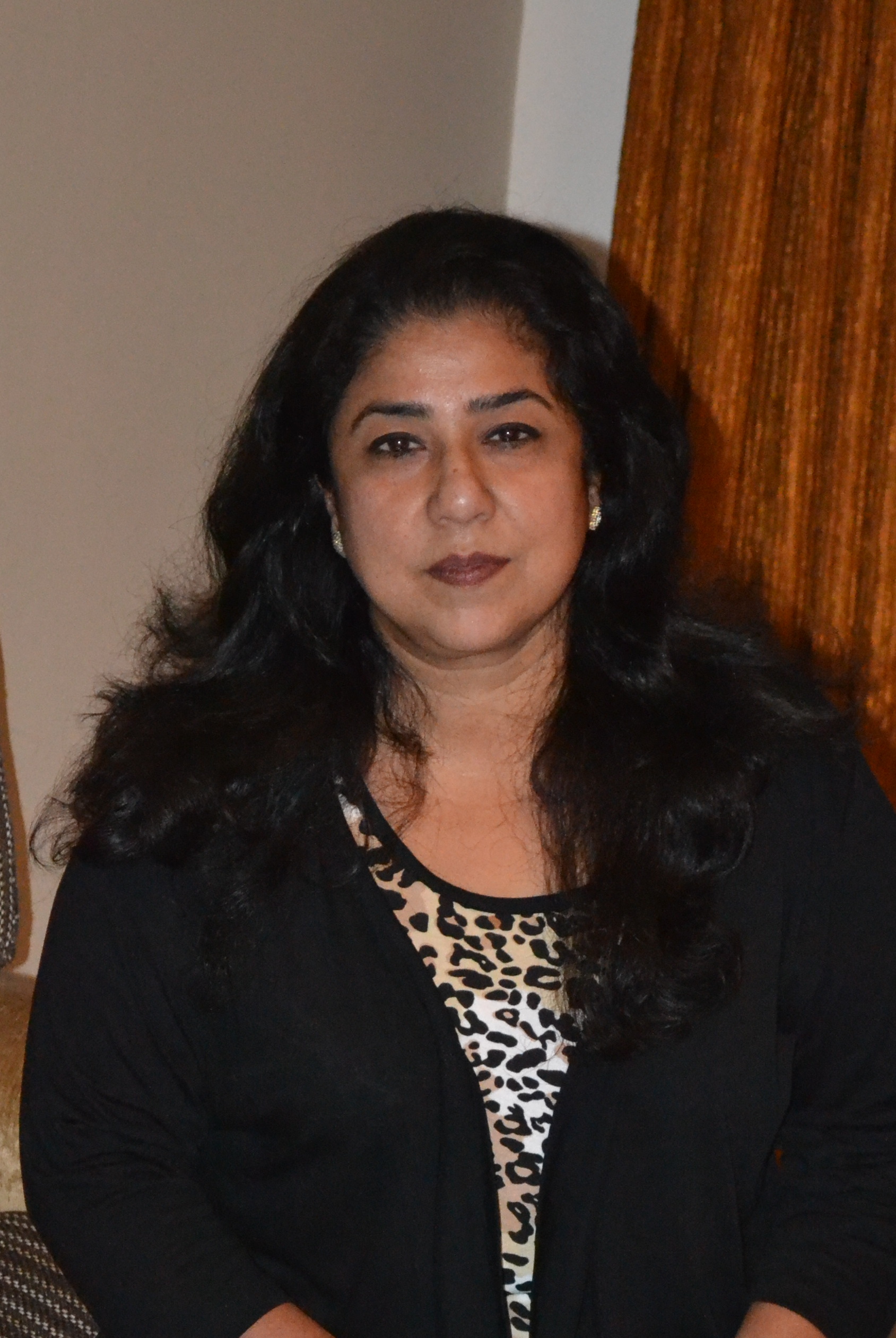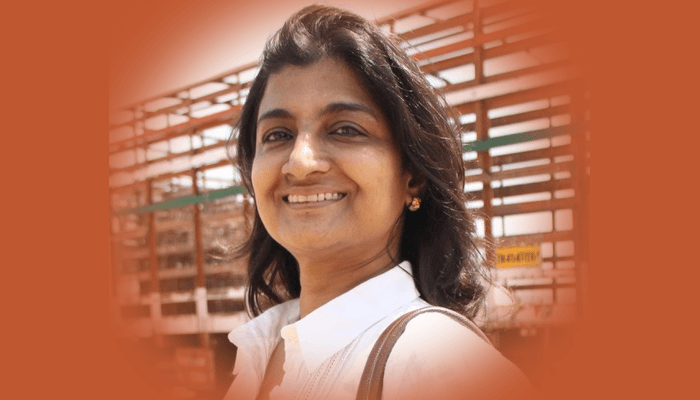An ‘accidental anthropologist’ gained international visibility for her famous Facebook research on peri-urban youth, VR dating and the Ameerpet IT hub, among other interesting studies. Read on for more insights into Dr. Nimmi Rangaswamy’s cutting edge work at the intersection of AI, HCI and Human Sciences at IIITH’s Kohli Centre.
“This is the first computer science department in India to hire a social anthropologist and that makes my role a little unique and also challenging”, says Dr. Rangaswamy. At IIIT Hyderabad, her research work at the frontiers of technology involve three groups – scientists, human computer interaction (HCI) designers and theoreticians in technology and society. “Research is a moving target and I’m very excited to be in the space where we are working at the confluence of AI and anthropology.”
The Professor at IIITH’s Kohli Centre on Intelligent Systems (KCIS) brings formidable industry experience from her tenure at Microsoft Research and Xerox where she combined theoretical approaches with ethnographic field research methods to study technology usage in peri-urban and rural communities.
The Accidental Anthropologist
How did a baby boomer who didn’t grow up with technology, find her moorings in HCI? Tracing her unusual story takes us to her early roots in Chennai. “I was born in a Tamil Brahmin family, where everyone was either in IT or IIT!”, she quips. “Amidst this hype, it was sacrilegious that I opted for a career in sociology and anthropology. But, as fate would have it, I married an IIT professor. I was surrounded by conversations that helped me understand their experiences in the structural context of technology.”
After her M.Phil. from Delhi School of Economics, Dr. Nimmi Rangaswamy would complete her Ph. D on a UGC fellowship from the University of Mumbai. Her thesis on the ethno-history of the Dravidian movement and their identity politics through print media was to be the fore-runner for an immersive career, which would produce over 100 co-authored publications in top-tier conferences and peer-reviewed journals. Up until 2000, Nimmi considered herself a conservative academic, cocooned in the Marxist ecosystem of Delhi and Bombay’s university culture. “My mindset changed once I started realizing that Marxism was losing its relevance and transitioned into the technology boom of early 2000.”
A family move to Chennai saw Dr. Rangaswamy join IIT Madras (2002-04), as a fellow with the TeNet group. Under Dr. Ashok Jhunjhunwala’s guidance, she would research the new wireless technologies and how rural telephony and rural Internet was being deployed in villages, from a socio-anthropological angle.

The famous Facebook study “that continues to haunt”
Microsoft Research Lab had just been launched in Bangalore and the young anthropologist joined the technologies for emerging research department. “I actually gained notoriety for my Facebook research in Microsoft”, chuckles Nimmi. The study followed teenagers, the gatekeepers of technology and first-users of cheap smartphones, who used Facebook, among other things, to learn English and woo girls who were out of their league in real life. “I probably wrote three papers on Facebook, but have given over 40 keynotes and talks on it.”
“I was working remotely, living in Mumbai since my husband was in IIT Bombay. I was the only anthropologist-social scientist in an eclectic team that comprised an economist, product developer, physicist and designers” she notes. She remembers her 9-year stint at Microsoft Research as “formative years of such precious learning. It taught me to navigate the corporate hierarchy and made my research visible in a space where the stakes were much higher, especially since I was working remotely. That is what got me into publishing aggressively and changed my whole outlook”.
A polyglot in social research
“If I hadn’t experienced the industry-facing aspect of my craft, I would still be in an ivory tower as an anthropologist, speaking that one language”, she observes. “My entire repertoire of communication changed dramatically. I learned to converse in multiple social research languages, to morph into the skin of a designer or a computer scientist.”
In 2013, when transitioning between Microsoft and Xerox, Dr. Rangaswamy joined IIT Hyderabad as an adjunct professor, where she taught a course in digital society, technology and development. Around the time that she was leaving Xerox, she got an interview call from IIITH and decided to take the plunge back into academia.
After 12 years in industry research, she hung up her corporate boots to take up a challenging post as anthropologist at IIIT Hyderabad, a bold move that she has never regretted. “I’m a very happy academic now”, she reports. “I think I was blessed to get an amazing bunch of students when I started out in 2017. The first three years before COVID hit were some of my best years, working with brilliant batches of students. I graduated five students in the first four years that resulted in several interesting papers”.
A seasoned mentor with a thespian flair
“Sometimes you need a Zoya Akhtar’s vision of community, more than Max Weber to hold the attention of a class and proceed to understanding it more formally as a social scientist”, explains the professor who would begin a lecture on Dharavi’s ecosystem by playing ‘Doori’ from Gully boy.
“My lectures are quite performative and interactive. My fondest memory is how my mode of teaching was well received in those first few years. My first class started with 16 students, and in four years I had 190 students registering for my course. My pedagogy was shaped and fine-tuned in IIITH and I think those are my fondest memories. I shared a very special relationship with students only because the Institute gave me the freedom to build my course and teach it the way I wanted.”
Dr. Rangaswamy has curated two electives on ‘Technology and development’ and ‘Social science perspective on HCI’. She also teaches courses on Introduction to human sciences and Research methodology. She is currently engaged in interdisciplinary research with her students on AI fairness and extreme speech, bringing together computational and anthropological methodologies. She has submitted cutting edge research proposals along with CS professors, one of them with Prof. Kamalakar Karlapalem that aligns data sciences with anthropology.
Whether it was the interdisciplinary thesis on feminism and social media platform politics of Sabarimalai, the triple talaq case or the ethnographic study on IT skill training hubs in Ameerpet (that featured in at least 20-25 talks), Dr. Rangaswamy has always irreverently teased the boundaries of her craft.
A shop floor ethnography on nine companies sought to understand what makes an industry automate its work processes. Interesting insights were gleaned from an ethnographic study of Uber drivers and the HCI of everyday driving of Uber, with a sociological perspective of the gig economy driving it. One student’s paper studied the intersections of technology and human-centrism in the aadhaar study while another quirky experiment explored the VR dating scene in a college. In a study that spanned a decade, her first Ph.D student has just submitted his thesis in digital humanities; on Indian miniature folk paintings with the view to extract universal formal properties of specific art forms.
Technology and development studies have been my moorings, says the social scientist who is a member of the international advisory board of the United Nations University Institute in Macau. She has an enviable track record of publications in top tier conferences like SIGCHI, CSCW, ICTD, IFIP and COMPASS. She is slated to deliver a keynote talk at a workshop at ACM FAccT on June 21st. The Ethnographic Praxis in Industry Conference (EPIC) has been close to her heart for the last 17 years; as a publishing author, organiser and now as Paper Chair at the 2022 Amsterdam conference.
Dr. Rangaswamy is an empaneled examiner at several universities including IIT Bombay and Hyderabad, University of Hyderabad and NID Ahmedabad and consultant with IIIT Delhi, NID Bangalore design department and IIT Gandhinagar for their digital humanities.

What drives the perpetual Witness?
“Chennai city inculcated the love of reading, music and films, three things that shaped my life”, says Dr. Nimmi Rangaswamy. As a youngster, she dabbled in amateur drama. Her thespian flair would later spill over into her lectures. Says the movie buff who belongs to an online cinema appreciation community, “I watch as many movies as I can, read and reflect upon it and that’s how I de-stress.” Ten laps around the swimming pool keeps her body fit and her brain buzzing like a chainsaw. When her son went abroad for higher studies, she had to deal with an empty nest syndrome. Not one to waste a good crisis, she channeled her angst into research and 2014 would become the most productive year of her life.
“What truly gives me joy is that whether it’s a movie, book, academic paper or even a group discussion, when I suddenly land on an insight about human behaviour, it blows my mind”, she admits. “I don’t know if it is the anthropologist in me but what gives me a high is when a conversation brings me closer to understanding human behaviour”.

Deepa Shailendra is a freelance writer for interior design publications; an irreverent blogger, consultant editor and author of two coffee table books. A social entrepreneur who believes that we are the harbingers of the transformation and can bring the change to better our world.


Nimmi Rangaswami has truly aced the intersection of human sciences with technology. She must be commended for her studies on technology inspired social behaviour among the youth that gave them the agency to transform themselves into an identifiable segment of society with huge potential to influence and direct social norms.
Saraswathi Unni says: